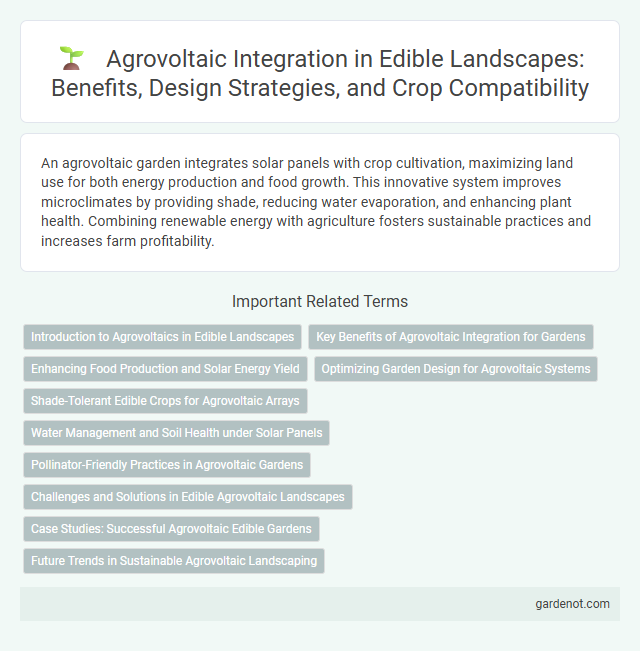An agrovoltaic garden integrates solar panels with crop cultivation, maximizing land use for both energy production and food growth. This innovative system improves microclimates by providing shade, reducing water evaporation, and enhancing plant health. Combining renewable energy with agriculture fosters sustainable practices and increases farm profitability.
Introduction to Agrovoltaics in Edible Landscapes
Agrovoltaics integrates solar energy production with agricultural cultivation, enabling edible landscapes to generate renewable energy while maximizing land use efficiency. This system supports diverse crops under solar panels, optimizing photosynthesis and water usage through shade and microclimate effects. Implementing agrovoltaic gardens enhances sustainable food production, lowers carbon footprints, and promotes energy resilience on agricultural land.
Key Benefits of Agrovoltaic Integration for Gardens
Agrovoltaic gardens combine solar energy production with crop cultivation, enhancing land use efficiency by generating renewable power while supporting plant growth. This integration improves microclimates for crops, reducing water usage and increasing yield stability under variable weather conditions. Energy generated onsite lowers operational costs and promotes sustainable food systems through reduced carbon footprints.
Enhancing Food Production and Solar Energy Yield
Agrovoltaic gardens integrate solar panels with edible landscapes, optimizing land use by simultaneously generating solar energy and cultivating food crops. This dual-use approach boosts food production by providing partial shading that can improve crop resilience and water efficiency while increasing solar panel efficiency through cooling effects from vegetation. Enhanced synergy between agriculture and solar technology maximizes energy yield and agricultural output, promoting sustainable and productive land management.
Optimizing Garden Design for Agrovoltaic Systems
Optimizing garden design for agrovoltaic systems involves strategic plant placement to maximize sunlight exposure beneath solar panels while enhancing crop yield. Implementing shade-tolerant and drought-resistant edible plants creates a symbiotic environment that leverages partial shading and conserves soil moisture. Incorporating sensors and data-driven irrigation ensures efficient resource use, promoting sustainability and productivity in edible landscapes integrated with photovoltaic technology.
Shade-Tolerant Edible Crops for Agrovoltaic Arrays
Shade-tolerant edible crops such as leafy greens, herbs, and root vegetables thrive in agrovoltaic gardens by maximizing space under solar panel arrays while maintaining high productivity. These crops adapt to reduced sunlight conditions, improving soil health and biodiversity beneath the panels. Integrating shade-adapted varieties enables sustainable food production alongside renewable energy generation, enhancing land-use efficiency.
Water Management and Soil Health under Solar Panels
Agrovoltaic gardens optimize water management by integrating drip irrigation systems that reduce evaporation and promote efficient water use beneath solar panels. Shaded conditions under panels help maintain soil moisture, reducing the need for frequent watering and mitigating soil erosion. Enhanced soil health is supported through organic mulching and composting practices that preserve nutrients and encourage beneficial microbial activity.
Pollinator-Friendly Practices in Agrovoltaic Gardens
Agrovoltaic gardens integrate solar panels with edible landscapes to create habitats that support pollinators essential for crop productivity. Implementing pollinator-friendly practices includes planting diverse native flowering species that bloom throughout the growing season, providing continuous nectar and pollen sources. These gardens enhance biodiversity by minimizing pesticide use and incorporating nesting sites, which encourage pollinator visitation and improve overall ecosystem health.
Challenges and Solutions in Edible Agrovoltaic Landscapes
Edible agrovoltaic landscapes face challenges such as managing shading effects on crop growth and balancing land use between solar panels and edible plants. Solutions include selecting shade-tolerant crops, optimizing solar panel height and spacing for adequate sunlight, and integrating water-efficient irrigation systems to enhance plant resilience. Innovations in agrovoltaic design and precision agriculture technologies improve productivity and sustainability in these multifunctional landscapes.
Case Studies: Successful Agrovoltaic Edible Gardens
Case studies of successful agrovoltaic edible gardens demonstrate enhanced crop yields by integrating photovoltaic panels with diverse fruit and vegetable cultivation. Sites like the Fraunhofer ISE pilot project in Germany showcase increased land productivity and optimized microclimates under solar arrays. Data from these projects report energy generation exceeding 15 kWh/m2 annually while maintaining or improving harvest quality and biodiversity.
Future Trends in Sustainable Agrovoltaic Landscaping
Agrovoltaic gardens represent a future trend in sustainable edible landscapes by integrating solar panels with crop cultivation, optimizing land use and energy production simultaneously. This innovative approach enhances biodiversity, improves microclimate conditions, and increases food security through efficient resource management. Advancements in adaptive panel technology and data-driven farming practices will drive the expansion of agrovoltaic systems worldwide.
Agrovoltaic garden Infographic

 gardenot.com
gardenot.com